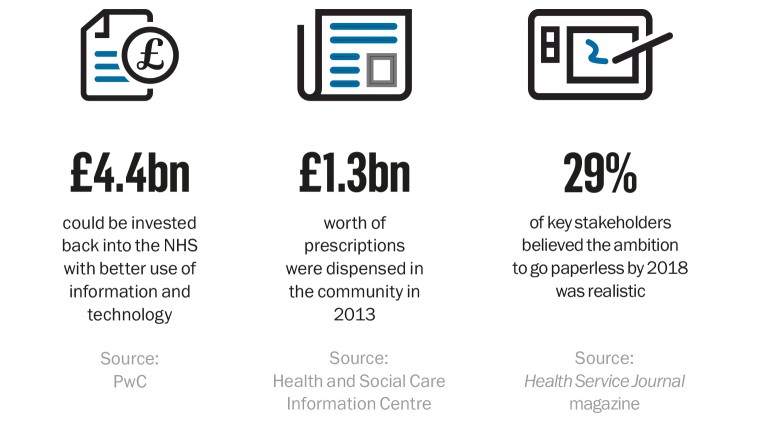With the probable outcome of the general election still very unclear, one thing is certain – the NHS will be a central issue as the political debate hots up. In particular, finance – how and where limited funds are spent and how money can be saved – will continue to be a focus.
Set against this background is a particularly striking figure. According to PwC, some £4.4 billion could be invested back into the NHS with better use of information and technology. Added to this is the fact that nearly a fifth of all office floor space in the UK is devoted to storing paper. For an organisation which employs millions of people and serves even more, the costs arising solely from this one element of paper record-keeping by the NHS must be vast.
In June 2013, Health Secretary Jeremy Hunt challenged the NHS to go paperless by 2018. “The NHS cannot be the last man standing as the rest of the economy embraces the technology revolution,” he said. Paperless technology, Mr Hunt argued in a speech to the Policy Exchange think-tank, would not only help the health service to save billions of pounds, but it would improve services and help to meet the challenges of an ageing population.
The Health Secretary told his audience that patients should have compatible digital records so their health information can follow them around the health and social care system.
One very easy-to-use and highly reliable piece of technology that is already common in many other sectors could benefit enormously the NHS ambition to go paperless – it’s the electronic signature
It’s a laudable aim. The fact is, though, that with this deadline just three years away, now the NHS is struggling. By next month everyone who wishes to do so should be able to get online access to their health records held by their GP. There should also be a system of paperless referrals and, instead of sending a letter to the hospital when referring a patient, the GP should send an e-mail. A year ago a survey for Health Service Journal magazine of key stakeholders revealed that just 29 per cent believed the ambition to go paperless by 2018 was realistic.

Electronic handwritten signature technology is already used in a number of sectors
One very easy-to-use and highly reliable piece of technology that is already common in many other sectors, ranging from banking to local government, could benefit enormously the NHS ambition to go paperless – it’s the electronic handwritten signature. This involves an employee or visitor signing with an electronic pen on to a screen as they would with a pen and paper. The benefits of the electronic version, though, are significant.
For example, there is no need for a single piece of paper to circulate in an office and risk getting lost, damaged or falling into the wrong hands. Private-sector organisations and now a growing number of public bodies around the world are also appreciating the fact that the various parties can sign a document even if they’re not physically present in the office. This speeds up approval processes and other decisions hugely.
But not all electronic-signature technology is the same. “People worry about fraud because signatures aren’t captured accurately,” explains Mark Hoole, eDocs UK key account manager at Wacom Europe, the leading provider of electronic handwritten technology. “But our technology is more accurate and sophisticated than the scratchy, pixelated signature gadgets we’ve all used for a delivery, for instance.”
Over the last few years commercial sectors around the world have been enjoying the significant benefits offered by electronic handwritten signatures. More recently they’ve been joined by an increasing number of public-sector organisations. As it continues its important journey towards becoming paperless, Wacom electronic handwritten signature technology can play a vital role in helping the NHS.

SAVING MORE THAN A BILLION PIECES OF PAPER WITH PRESCRIPTIONS ALONE
According to the Health and Social Care Information Centre, more than 1.03 billion prescriptions were dispensed in the community in 2013, compared with 649.7 million in 2003, an increase of 58.5 per cent. Currently many GPs are sending prescriptions electronically to pharmacists. However, the pharmacist then has to print them out for the patient to sign. An electronic handwritten device on the pharmacist’s counter would make the system truly paperless, removing over a billion pieces of paper from the system and saving the NHS millions of pounds.
HOW IT WORKS
Founded and headquartered in Japan, with offices in Europe, the United States and China, Wacom has been creating products and services, for some 30 years, that help industry leaders push the boundaries of film and 3D animation in industry design, digital art and game development. Having created pen technology for tablets, it began ten years ago to take the same high-tech, innovative approach to electronic handwritten signatures.
Wacom systems use highly sophisticated technology to ensure the greatest possible accuracy and security. Screens have a very high resolution and, along with the pens, they pick up minute biometric data including every movement and subtle nuance of the human hand as it writes. This could also mean the speed, force and angle at which the pen hits the screen. How i’s are dotted and t’s crossed, the way people create loops when writing, and even how long it takes for the person signing to move from one letter to the next are measured and recorded with minute precision.
“This remarkable level of accuracy, combined with the signature being captured only as a data stream using a Wacom pen and screen, means that signature fraud could become a thing of the past,” explains eDocs UK key account manager at Wacom Europe Mark Hoole. “This is one of the reasons why so many banks use the company’s technology. It also gives the experience of a natural signature.”
Even with this high level of security, the systems are also flexible. Thanks to a wide range of pens, Wacom technology also works easily with tablets and smartphones. The screens and pens are remarkably tough. In one test, even after half a million signatures, the screen was unmarked.


